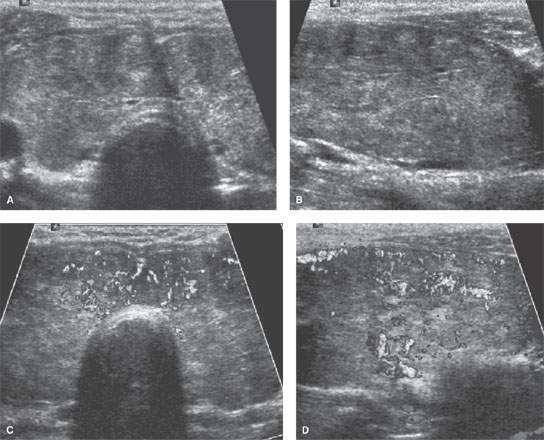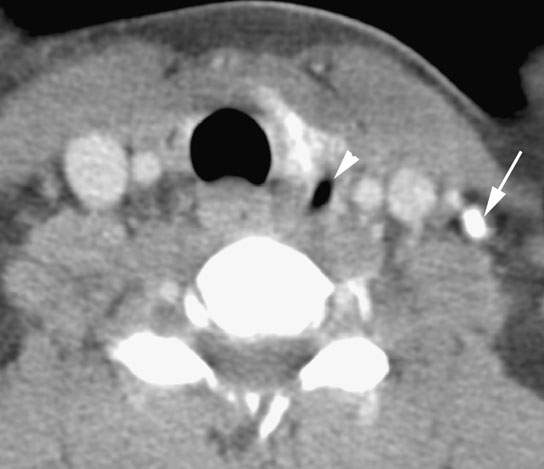THYROID GLAND INFLAMMATORY DISEASE AND TRAUMA
KEY POINTS
- Imaging is usually of limited value in thyroid inflammatory conditions.
- Imaging can suggest an alternative diagnosis or associated diagnosis of thyroid cancer in some patients believed to have an inflammatory condition.
- Especially in acute situations, the airway may be at risk.
- Rarely, imaging will suggest a risk of thyroid storm.
- Evidence of inflammatory disease of the thyroid may be seen incidentally on studies done for other purposes and is occasionally the first confirmation of such a disease state.
- Ultrasound may be used in surveillance for lymphoma, which can arise as a secondary effect of chronic autoimmune thyroiditis.
This chapter summarizes the limited role of imaging in thyroid inflammatory disease and trauma. The clinical setting and evaluation including laboratory (mainly thyroid function) studies will almost always define the problem and lead to a disease management plan. Imaging may contribute when these circumstances are not clear. When done without critical forethought, imaging is often not really important or truly useful in the diagnostic process.
ANATOMY OF SPECIFIC INTEREST
The anatomy of the neck is discussed in general in Chapter 149 and with regard to the thyroid in Chapter 169.
The anatomy of specific interest in this chapter includes the thyroid and its relationships to the cervicothoracic junction and mediastinum, recurrent laryngeal nerve, esophagus, and trachea.
IMAGING ISSUES RELATED TO THYROID GLAND INFLAMMATORY CONDITIONS
Acute and Subacute Infectious Thyroiditis
Acute suppurative thyroiditis is a relatively rare disease that may be due to upper respiratory pathogens that somehow enter the gland. Infection can also be caused by bacteria, viruses, and parasites. The limited role of imaging in this disease is mainly to exclude an abscess. Subacute infectious thyroiditis may be due to a variety of common viruses, bacteria, and fungi as well as catscratch disease and sarcoidosis (Fig. 173.1). The overall evaluation of the condition is more based on clinical factors and thyroid function studies. Specific therapy will be directed by identifying the infectious agent and managing thyroid functional consequences (Fig. 173.2).
Chronic Infectious Thyroiditis
Chronic thyroid infections are rare and sporadic occurrences that may mimic thyroid cancer in their presentation, both clinically and on imaging. These may be discovered as part of an evaluation of low neck adenopathy or just signs of inflammation in the low neck (Fig. 173.3). Chronic recurrent abscesses in the low neck may be due to infection of a branchial apparatus cyst, some of which tend to present in the tissues around the thyroid in the low neck as discussed in detail in Chapter 153.

FIGURE 173.1. A patient presenting with acute thyroid swelling and severe lower neck tenderness over the thyroid region proven to be due to acute bacterial thyroiditis. A, B: Transverse and sagittal views of the thyroid gland showing a diffuse enlargement with a diffusely abnormal texture of the gland. No abscesses were seen. The trachea was slightly displaced and compressed from anteriorly. C, D: Images from a color flow Doppler study in black and white showing diffuse hypervascularity within the gland consistent with reactive but nonspecific hyperemia.
Chronic Autoimmune Thyroiditis (Hashimoto Disease)
Chronic thyroiditis is discussed in detail along with other autoimmune diseases in Chapter 20. Imaging may be done in chronic autoimmune thyroiditis when it mimics a malignancy (Chapter 172) or goiter (Chapter 171). Ultrasound has been used for surveillance for lymphoma in patients who might develop that disease as a secondary effect of chronic thyroiditis.
The functional effects of chronic thyroiditis on the thyroid gland may be seen as incidental abnormal tracer accumulation on studies done for other reasons, especially on radionuclide studies such as those done using gallium or fluorine-18 2-fluoro-2-deoxy-D-glucose positron emission tomography (FDG-PET). Its anatomic effects, whether due to active or end-stage disease, may similarly be seen incidentally on computed tomography (CT) and magnetic resonance imaging (MRI). The late effects of thyroiditis may be seen as a small gland; rarely, such imaging may be the first clinically obvious explanation of that disease state (Figs. 173.4–173.7). The imaging may be done to identify a possible cause of airway and/or esophageal compressive symptoms, and findings consistent with thyroiditis as an explanation for those symptoms may be present.
Imaging is typically not used in this disease when chronic autoimmune thyroiditis is the primary working clinical diagnosis. Any elective imaging in the setting of likely chronic thyroiditis should be delayed until proper medical evaluation including thyroid function studies has been completed.
If there is a suggestion of possible inflammation clinically and CT or MRI is performed, such imaging should include contrast injection.
IMAGING ISSUES RELATED TO THYROID GLAND TRAUMA
The effects of thyroid trauma are usually identified on studies of the neck aimed more at evaluating laryngeal and cervical spine injury than that to the gland. The gland may be fractured or just diffusely swollen. These injuries usually resolve without clinical consequence (Figs. 173.8 and 173.9). The main clinical concerns will be an expanding hematoma that might compress the trachea and thyroid dysfunction, which in its most severe form could present as life-threatening thyroid storm.

FIGURE 173.2. Contrast-enhanced computed tomography study of a patient with cervical adenopathy that was calcified (arrow) and a thyroid infection with localized abscess (arrowhead) due to Morganella.
Stay updated, free articles. Join our Telegram channel

Full access? Get Clinical Tree








